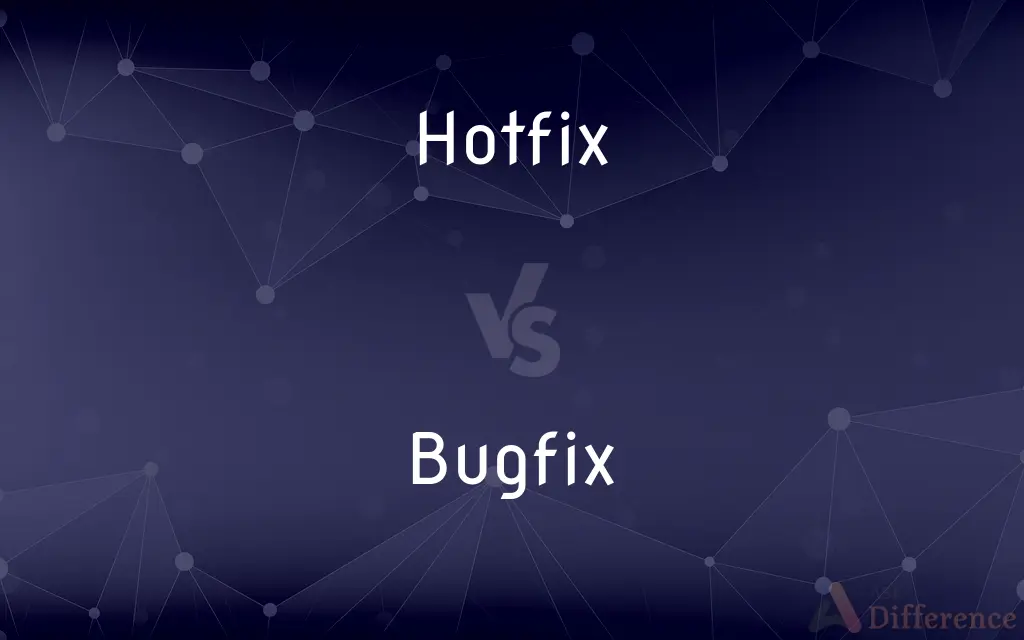Hotfix vs. Bugfix — What's the Difference?
By Maham Liaqat & Urooj Arif — Updated on March 14, 2024
A hotfix addresses urgent issues in live systems without downtime, whereas a bugfix corrects errors in software, often in the next scheduled update.

Difference Between Hotfix and Bugfix
Table of Contents
ADVERTISEMENT
Key Differences
Hotfixes and bugfixes are essential components of software maintenance, addressing issues that could potentially disrupt the user experience. However, they serve slightly different purposes and are applied under different circumstances. A hotfix is usually deployed to solve a critical issue in a live environment, aiming to ensure the system's stability and security without requiring a system restart or significant downtime. This urgency and the need to apply the fix immediately differentiate a hotfix from a standard bugfix. Bugfixes, on the other hand, are more routine corrections made to software to resolve errors or "bugs" identified by users or developers. These fixes are typically included in scheduled updates rather than being applied on an emergency basis.
Hotfixes are generally applied to live systems, focusing on urgent and critical issues that need immediate attention to prevent potential service disruptions or security vulnerabilities. They are usually temporary and quick fixes that address specific problems until a more comprehensive solution can be developed and deployed as part of a regular update. On the other hand, bugfixes involve a more thorough process, including testing and integration into the software's next version or update. This approach allows for a more stable and permanent solution but lacks the immediacy of a hotfix.
The deployment process for hotfixes and bugfixes also differs significantly. Hotfixes are often applied directly to production environments to immediately address critical issues, whereas bugfixes undergo a more traditional software development lifecycle, including testing in staging environments before being rolled out with scheduled software updates. This difference highlights the balance between the need for quick fixes and the importance of ensuring that the solution does not introduce new problems.
While hotfixes are typically focused on urgent fixes for critical issues, bugfixes can address a wider range of problems, from minor glitches to significant bugs affecting software functionality. The scope of what is considered a bugfix is therefore broader, encompassing anything from performance improvements to enhancements that improve the user experience. This distinction underscores the different priorities and approaches in software maintenance and development.
The decision to deploy a hotfix or a bugfix is often based on the severity and impact of the issue at hand. For critical problems that pose immediate risks to system stability or security, a hotfix is usually the preferred solution. In contrast, issues that do not require immediate action are addressed through the regular bugfix process, allowing for comprehensive testing and integration. This strategic choice ensures that the software remains functional and secure while minimizing disruptions to users.
ADVERTISEMENT
Comparison Chart
Purpose
To quickly address critical issues in live systems
To correct errors in software during scheduled updates
Urgency
High, implemented immediately
Lower, implemented in the next update
Deployment
Directly to live systems without significant downtime
Through scheduled software updates
Scope
Critical, urgent issues
Broader range of software errors
Testing
Limited due to urgency
Extensive, as part of the software development cycle
Compare with Definitions
Hotfix
A temporary fix applied to a production environment.
The hotfix stabilized the system until a permanent solution was ready.
Bugfix
A solution to a reported or discovered software bug.
The development team worked on a bugfix for the memory leak.
Hotfix
A quick solution to a critical issue in a live system.
A hotfix was applied overnight to patch a security vulnerability.
Bugfix
A part of routine software maintenance to correct errors.
Regular updates will include bugfixes for known issues.
Hotfix
An emergency update released to fix a specific problem without downtime.
The hotfix resolved the login issue without interrupting service.
Bugfix
A correction for an error in software code.
The latest update includes a bugfix for the crashing issue.
Hotfix
Immediate corrective action for urgent software problems.
An encryption flaw necessitated an immediate hotfix.
Bugfix
An update that resolves software malfunctions.
The bugfix improved the app's stability significantly.
Hotfix
A rapid deployment to address critical vulnerabilities.
The team deployed a hotfix to close the security loophole.
Bugfix
An enhancement made to fix glitches or defects.
The bugfix addressed several minor user interface problems.
Hotfix
A hotfix or quick-fix engineering update (QFE update) is a single, cumulative package that includes information (often in the form of one or more files) that is used to address a problem in a software product (i.e., a software bug). Typically, hotfixes are made to address a specific customer situation.
Bugfix
(computing) A patch or change that fixes the unwanted behaviour caused by a bug.
Hotfix
(computing) A cumulative package of one or more files used to address a problem in a software product.
Common Curiosities
What is a hotfix?
A hotfix is an immediate, urgent fix applied to live systems to address critical issues without significant downtime.
Can a hotfix be a permanent solution?
Hotfixes are often temporary, meant to quickly address an issue until a more comprehensive, permanent fix can be deployed.
Are all software issues fixed with hotfixes?
No, only urgent and critical issues are addressed with hotfixes; less critical problems are resolved with bugfixes.
How do hotfixes differ from regular updates?
Hotfixes are applied urgently to fix critical issues without downtime, unlike regular updates which follow the software development cycle.
Why are bugfixes important?
Bugfixes are crucial for maintaining software stability, performance, and user satisfaction by correcting errors and defects.
How is a hotfix deployed?
A hotfix is deployed directly to a live system, often without the need for system restarts or significant downtime.
Are bugfixes tested before release?
Yes, bugfixes undergo extensive testing as part of the software development and update cycle to ensure they don't introduce new issues.
What is a bugfix?
A bugfix is a correction made to software to resolve errors, typically included in scheduled updates.
Can hotfixes introduce new problems?
Due to their urgent nature and limited testing, hotfixes can sometimes introduce new issues, though this is rare.
What triggers the need for a hotfix?
Critical issues that pose immediate risks to system stability, security, or functionality necessitate a hotfix.
How do developers decide between a hotfix and a bugfix?
The decision is based on the issue's severity and impact, with critical issues warranting a hotfix and less urgent problems a bugfix.
How often are bugfixes released?
The frequency of bugfix releases varies by software, typically occurring during scheduled updates or version releases.
Do hotfixes require user action to apply?
This depends on the system; some hotfixes may be applied automatically, while others might require user action.
What happens if a hotfix fails to resolve the issue?
If a hotfix fails, developers will typically work on a new hotfix or plan a more comprehensive bugfix for a future update.
Can bugfixes improve software performance?
Yes, besides fixing errors, bugfixes can enhance software performance and user experience.
Share Your Discovery

Previous Comparison
Resultant vs. Resulting
Next Comparison
Execution vs. PerformanceAuthor Spotlight
Written by
Maham LiaqatCo-written by
Urooj ArifUrooj is a skilled content writer at Ask Difference, known for her exceptional ability to simplify complex topics into engaging and informative content. With a passion for research and a flair for clear, concise writing, she consistently delivers articles that resonate with our diverse audience.














































